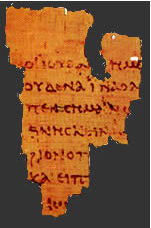John
Introduction
Background
Author
Christianity is a historical religion.
The apostles are the link between the historical events and our understanding today.
The book of John is the eyewitness account of the life of Jesus by one of his disciples, John.
The author:
a) Was a Jew
b) Had
first hand knowledge of the cities, places, and the lay of the land in
c) Was
very familiar with
d) Understood Judaism and its practices, beliefs and schools of thought.
Irenaeus, bishop of Lyons, Gaul in 177 AD says that John the apostles “issued” (“exedoke” meaning “gave out or “published”) this gospel in Ephesus. He said:
“John, the discipleof the Lord, who also had
leaned upon his breast, had himself published a gospel during his residence in
The Muratorian Fragment from 170 lists the books accepted by the church at this time. Along with listing the names of the books it also tells the origin of each book.
This Muratorian Fragment tells that John was the author of this book.
Date
Irenaeus says that John lived until the reign of Trajan. Trajan began to reign in 98 AD and continued until 117.
Even early Christians believed and wrote that John’s gospel was the fourth gospel.
So church history is unanimous that Matthew, Mark and Luke where already in existence when John wrote his gospel.
This helps us to understand why John is different than the first three gospels and does not repeat many of the same stories and teachings. John gives us a different look than what was already available.
93% of John’s material does not occur in the other three Gospels (called “Synoptics” because they are all similar)
Critics have placed the writing of John around 160 AD.
But we have references by writers before that date apparently referring to John’s gospel:
1) Justin Martyr (145 AD) writes:
a. “Christ said, ‘Except you be regenerated you shall not enter the kingdom of heaven.’ ”
b. “It is plain that it is impossible for those who were born once for all to enter into their mothers womb” (John 3:3-5)
2) Tatian a disciple of Justin Martyr wrote a harmony of the four gospels, known as the Diatessaron, before 170 AD. If the Gospel of John had recently been forged it would not have qualified to be included.
3) Ignatiaus who was martyred around 117 under Trajen apparently quotes from the gospel of John twice:
a. John 3:8 when he says the Spirit knows “whence it cometh, and whither it goeth”
b. John 7:38 where he says he no longer has a desire for material things but only “the living water.”
4) Egerton Papyrus 2 – Three papyrus codex leaves where acquired in 1925 that come from the 110-140 AD. The author of these papyri where familiar with the book Gospel of John where they make references to John 5: 39, 45; 9:29; 7:30; 10:39

Egerton Pyparias from 110-140 AC
5) John Ryland manuscript is a codex fragment of a copy of the gospel of John from 110-130 AD that contains John 18:31-33 on one side and 18:37, 38 on the other.

John Ryland’s Manuscript from 110-130 AD
Place of Writing
Destination
For Greek readers both believers and unbelievers because :
1) Prologue is in Greek thought
2) John:
a. Explains Jewish customs
b. Translates Jewish names
c. Locates Palestinian sites
3) 12:20-22 tells us that the Greeks came asking “to see Jesus.”
Occasion
Purpose
1) Present Jesus as divine. Although the first three gospel do the same this was one of John’s key reasons. John begins with the Word becoming flesh in 1:1 until Thomas exclaims “My Lord and My God” in 20:28.
2) Johns purpose statement is found in John 20:30-31
3) The verb “Believe” (“pisteuo”) is used 98 times in the book. But, the noun “faith” (“pistis”) is never used.
4) Other key words are:
a. Witness
b. Love
c. Abide
d. Counselor
e. Light
f. Life
g. Darkness
h. Word
i. Glorify
j. True
k. Real
5) These things are omitted in John’s gospel:
a. Genealogy
b. Birth
c. Baptism
d. The Temptations
e. Exorcising Demons
f. Parables
g. Transfiguration
h. Institution of the Lord’s supper
i.
Agony in
j. The Ascension
6) The Seven Signs – John focused on seven signs to prove Jesus was God
7) Each of the seven signs are followed by a discourse by Jesus explaining the sign.
8) There are Seven “I am” statements by Jesus
a. 6:35 – “I am the bread of life”
b. 8:12 – “I am the light of the world”
c. 10:7 – “I am the gate for the sheep” (10:9)
d. 10:11 –“I am the good shepherd” (10:14)
e. 11:25 – “I am the resurrection and the life”
f. 14:6 – “I am the way and the truth and the life”
g. 15:1 – “I am the true vine” (15:5)
Outline
Problems
1) Textual evidence shows 7:53-8:1 are not part of the original
2) Some believe chapter 20:31 was the original ending of the book and that chapter 21 was added later by John or someone else.
a. No manuscripts have ever been found without chapter 21.